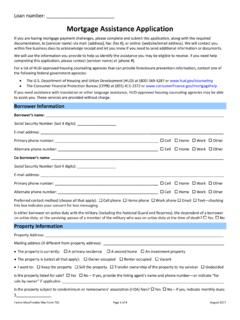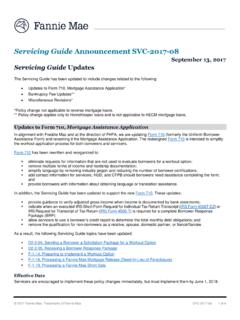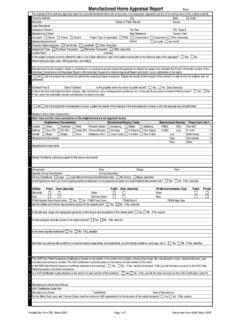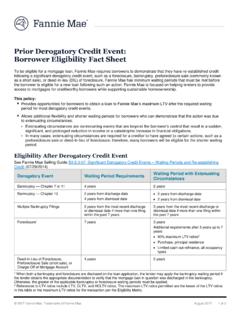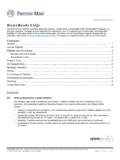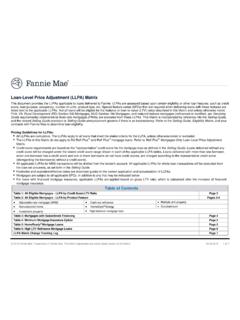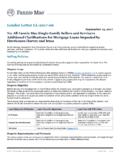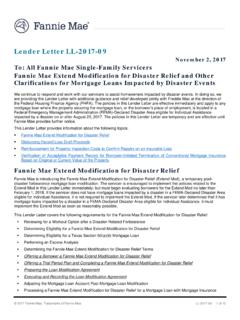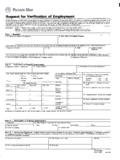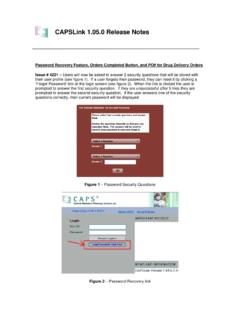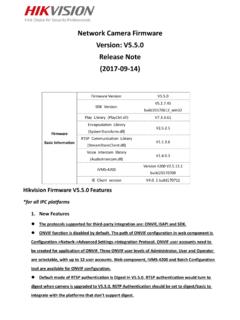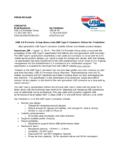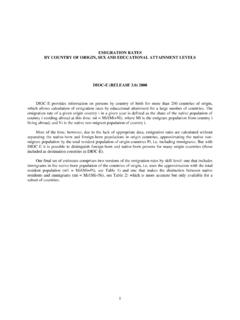Transcription of Desktop Originator/Desktop Underwriter Release …
1 2016 fannie Mae. Trademarks of fannie Mae. June 2016 1 of 10 Desktop Originator/ Desktop Underwriter Release notes DU Version February 23, 2016 Last Updated June 20, 2016 During the weekend of September 24, 2016, fannie Mae will implement Desktop Underwriter (DU ) Version , which will include the changes described below. To support our lending partners, fannie Mae continues to make ongoing investments in our risk management tools, enabling greater confidence and efficiency in the origination process. These tools help to provide the highest probability of loan performance over time, resulting in reduced costs to service those loans. We regularly review the DU risk assessment to provide certainty and clarity that the loan meets fannie Mae s requirements. The changes included in this Release will apply to new loan casefiles submitted to DU on or after the implementation of DU Version Loan casefiles created in DU Version and resubmitted after the implementation of DU Version will continue to be underwritten through DU Version The changes in this Release include: Updated DU Risk Assessment Underwriting Borrowers without Traditional Credit Policy Changes for Borrowers with Multiple Financed Properties HomeReady Mortgage Message Updates Updates to Align with the Selling Guide Retirement of DU Version Updated DU Risk Assessment DU Version will include an update to the DU credit risk assessment.
2 The updated credit risk assessment will continue to measure the likelihood of a loan becoming seriously delinquent; and is expected to have minimal to no impact on the percentage of Approve/Eligible recommendations that lenders receive today. Refer to Appendix A: Comparison of Risk Factors Evaluated by DU Versions and for the changes made to the risk factors with DU Version Trended Credit Data Credit reports currently used in mortgage lending indicate only the outstanding balance, utilization and availability of credit, and if a borrower has been on time or delinquent on existing credit accounts such as credit cards, mortgages, or student loans. DU Version will use trended credit data in the credit risk assessment, which provides access to historical monthly data (when available) on several factors, including: balance, scheduled payment, and actual payment amount that a borrower has made on the account.
3 Leveraging trended data in the DU risk assessment allows a smarter, more thorough analysis of the borrower s credit history. The use of trended data is a powerful predictor of risk, and its use enhances the DU risk assessment to better support access to credit for creditworthy borrowers. 2016 fannie Mae. Trademarks of fannie Mae. June 2016 2 of 10 The DU Version risk assessment will only use the trended credit data on revolving credit card accounts for the most recent 24 months payment history (even if more than 24 months worth of data is provided on the credit report). The trended credit data may be used on other types of accounts in a later version of DU. NOTE: The use of trended credit data by DU will not impact FHA or VA loan casefiles underwritten through DU. Underwriting Borrowers without Traditional Credit DU Version will include the ability to underwrite loan casefiles in which no borrowers have a credit score.
4 This update will automate what is currently a manual process for lenders. As with all loan casefiles underwritten through DU, a three-in-file merged credit report must still be requested for all borrowers on the loan application. However, when the credit report indicates a FICO score could not be provided for any of the borrowers due to insufficient credit, the loan casefile may be eligible to be underwritten using DU Version NOTE: Lenders must ensure that the credit report accurately reflects the borrower s information, such as the name, Social Security number, and current residence address of the borrower to confirm that the lack of traditional credit was not erroneously reported because incorrect information was used to order the credit report. Eligibility Guidelines To ensure the overall risk assessment is appropriate for loans involving borrowers without established traditional credit, DU will apply the following additional underwriting guidelines: Principal residence transaction where all borrowers will occupy the property One-unit property (may not be a manufactured home) Purchase or limited cash-out refinance transaction Fixed-rate mortgage Loan amount must meet the general loan limits (may not be a high-balance mortgage loan) LTV, CLTV, and HCLTV ratios may be no more than 90% Debt-to-income ratio must be less than 40% Loan casefiles that do not meet these guidelines will receive an Out of Scope recommendation.
5 Risk Factors Evaluated by DU DU will consider the following factors when evaluating the overall credit risk of borrowers who lack established traditional credit histories: Borrower s equity and LTV ratio Liquid reserves Debt-to-income ratio If a loan casefile does not receive an Approve recommendation, the lender may manually underwrite and document the loan according to fannie Mae s nontraditional credit guidelines as specified in the Selling Guide. Additional Documentation Requirements DU will require the verification of at least two non-traditional credit sources for each borrower that does not have traditional credit, one of which must be housing-related. A 12 month payment history is required for each source of nontraditional credit, which must be documented in accordance with the Selling Guide.
6 Loan Casefiles for Borrowers with Credit Scores With DU Version lenders may continue to use DU to underwrite loan casefiles that include a borrower(s) with traditional credit (a credit score) and a borrower(s) without traditional credit. However, the requirement that income used in qualifying for the loan cannot come from self-employment is being removed. 2016 fannie Mae. Trademarks of fannie Mae. June 2016 3 of 10 There will also be a change to the requirement that the borrower(s) with the credit score must contribute more than 50% of the qualifying income. When the borrower(s) with the credit score is contributing 50% or less of the qualifying income on the loan casefile, DU will issue a message requiring the lender to document a minimum of two sources of nontraditional credit that has been active for at least 12 months for the borrower that does not have traditional credit, one of the sources being housing-related.
7 Policy Changes for Borrowers with Multiple Financed Properties DU Version will reflect a simplified policy that will apply to loans for borrowers with multiple financed properties. The updated policy will require fewer eligibility overlays and updated reserve requirements, which will be automated by DU. NOTE: Additional detail on the changes to the multiple financed properties policy will be provided in a future Selling Guide update. In order for DU to accurately automate the updated guidelines, a Number of Financed Properties field will be added to the Additional Data section of the Desktop Originator (DO )/DU User Interface with the Release of DU Version This field will be used to capture the number of financed one- to four-unit residential properties (including the subject transaction) for which the borrower(s) are personally obligated.
8 DU will use the following approach in determining the number of financed properties that will be used in assessing the eligibility and reserve requirements for the loan casefile: When the Number of Financed Properties field is provided, DU will use that amount as the number of financed properties. When the Number of Financed Properties field is not provided, DU will use the number of residential properties in the Real Estate Owned (REO) section that include a mortgage payment, or are associated to a mortgage or HELOC in the liabilities section of the loan application, as the number of financed properties. When neither the Number of Financed Properties field nor the REO information has been provided, DU will use the number of mortgages and/or HELOCs disclosed in the liabilities section of the loan application as the number of financed properties.
9 When none of the information above is provided on the loan application, DU will use the number of mortgages and HELOCs disclosed on the credit report as the number of financed properties. NOTE: In order to account for the subject property, DU will add 1 to the number of financed properties on purchase and construction transactions when the REO section, number of mortgages on application, or number of mortgages on credit report is used as the number of financed properties. DU will issue a message informing the lender what amount was used as the number of financed properties and where that information was obtained (new field, REO section, number of mortgages on application, or number of mortgages on credit report). If DU used the information provided in the new field or in the REO section as the number of financed properties, and that information is inaccurate, the lender must update the data and resubmit the loan casefile to DU.
10 If DU used the number of mortgages and HELOCs on the loan application or credit report as the number of financed properties, and that number is inaccurate, the lender should provide the correct number in the Number of Financed Properties field, or complete the Real Estate Owned section of the loan application and resubmit the loan casefile to DU. For details on the implementation of the new Number of Financed Properties field, refer to the DU Version Integration Impact Memo Eligibility Guidelines DU will use the number of financed properties amount (as determined above) to apply the following eligibility guidelines: A minimum credit score of 720 is required for borrowers with 7 to 10 financed properties. 2016 fannie Mae. Trademarks of fannie Mae. June 2016 4 of 10 Borrowers are limited to a maximum of 10 financed properties.
